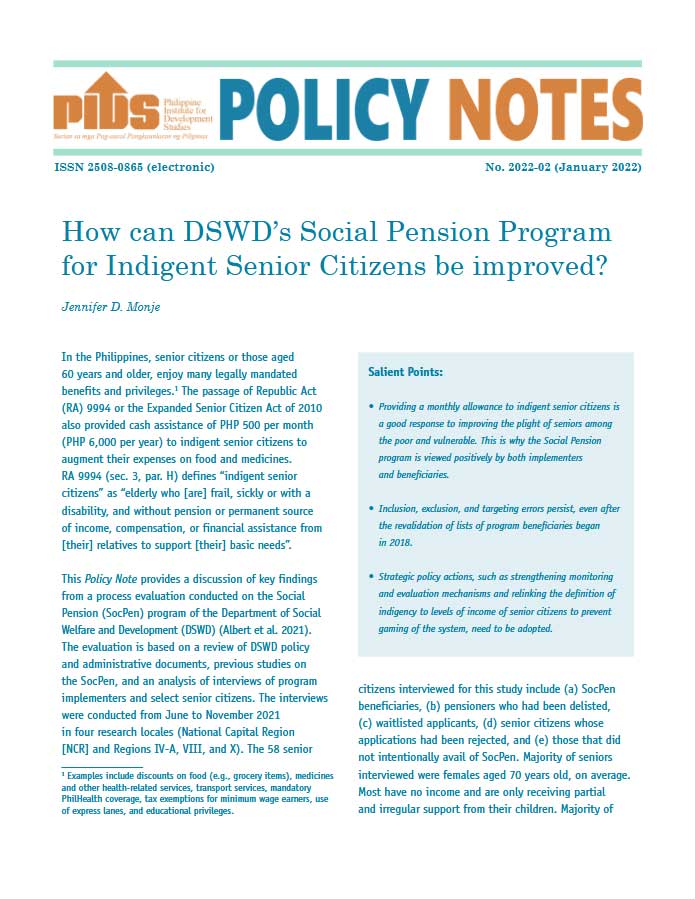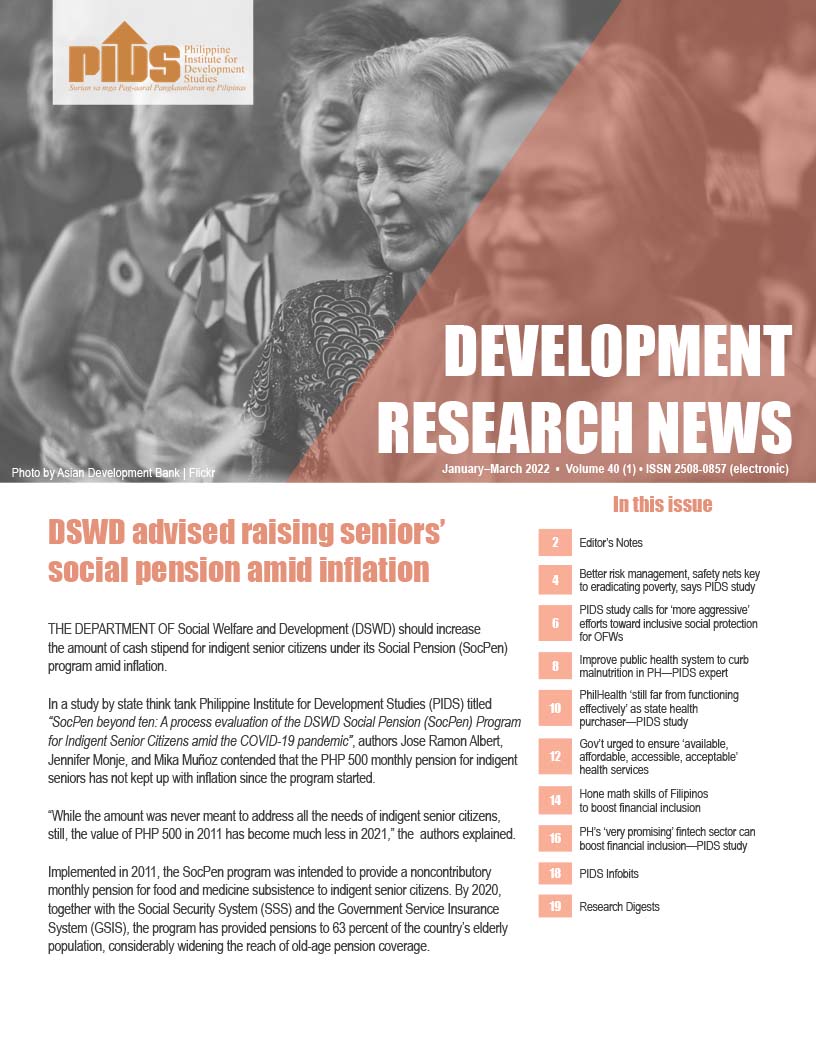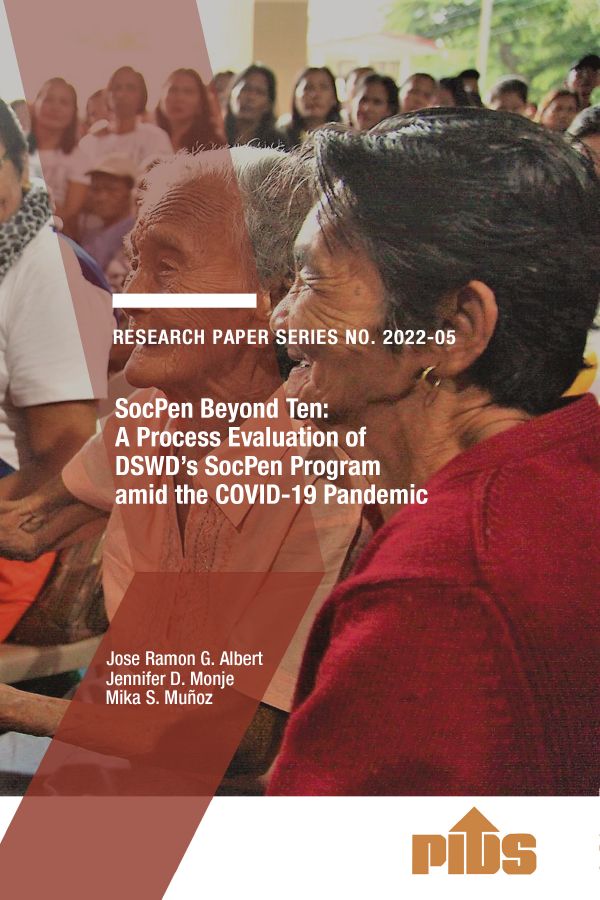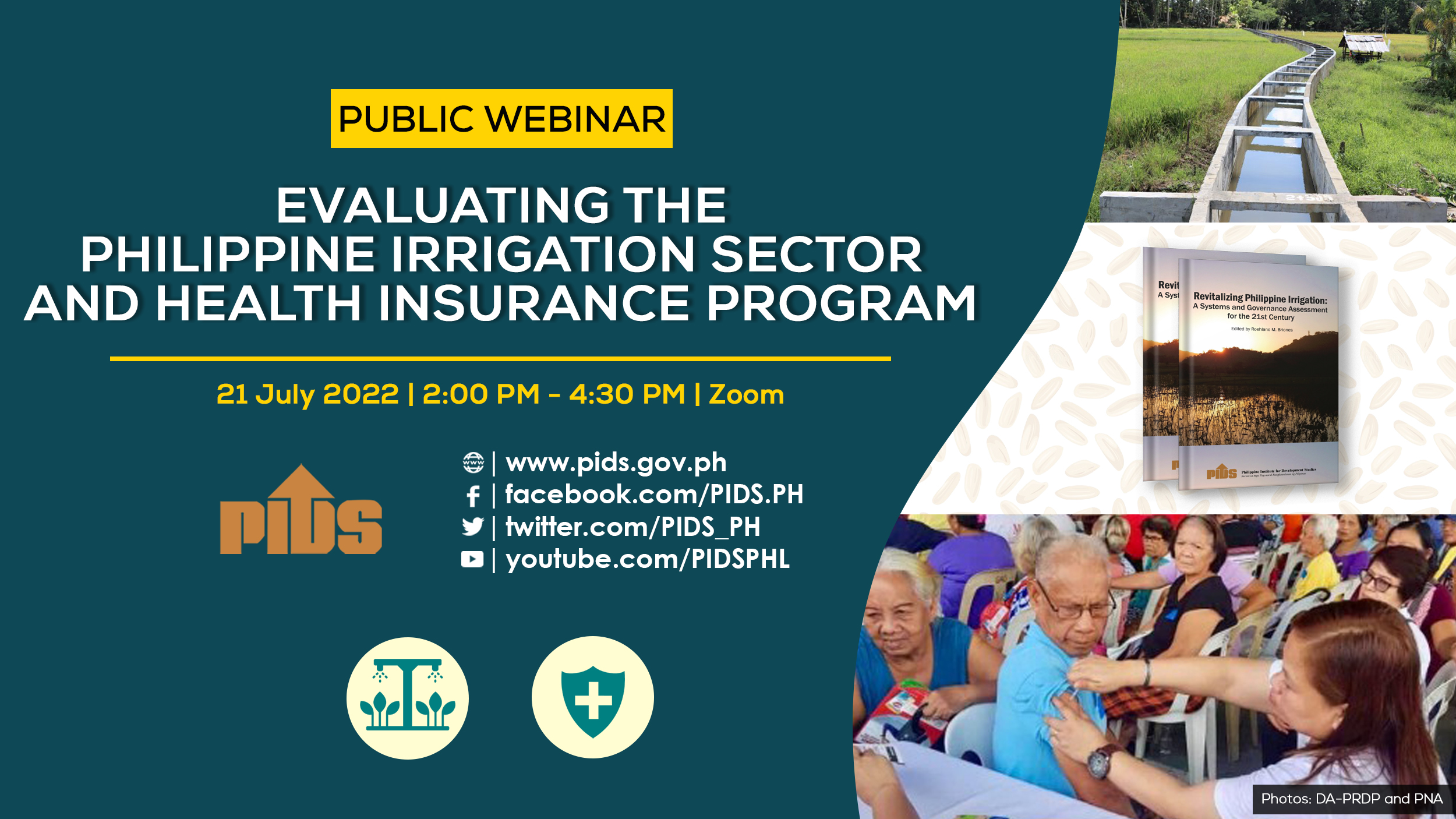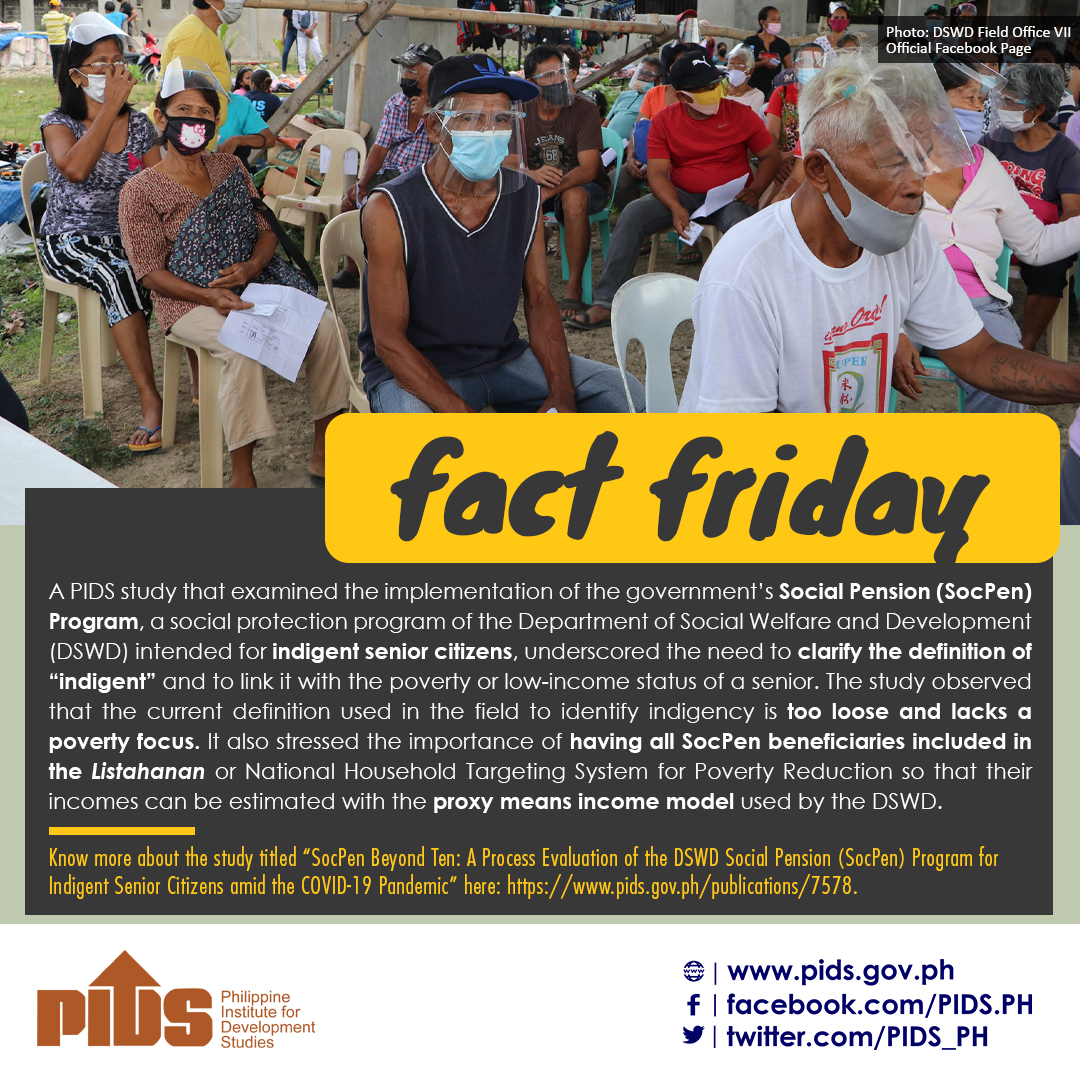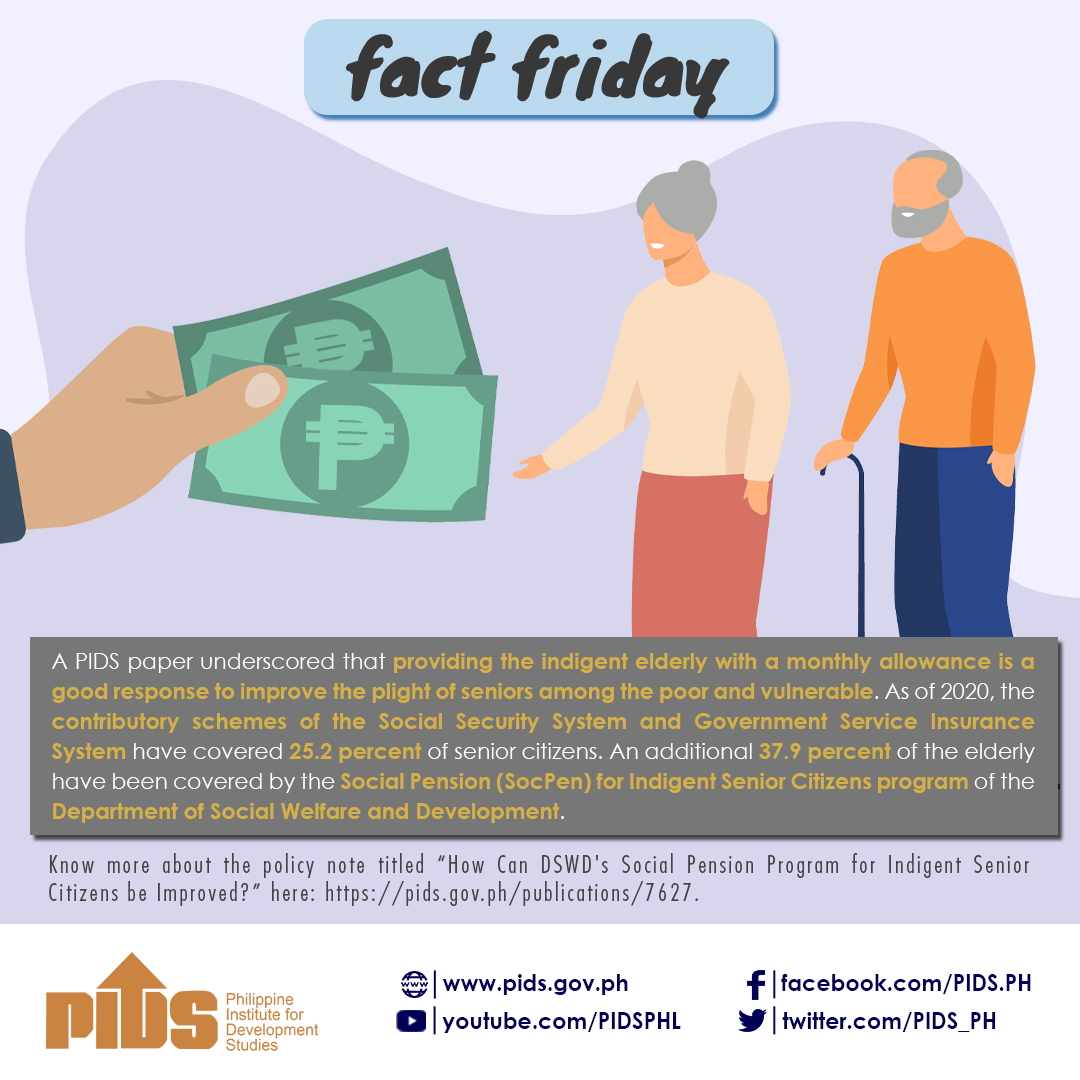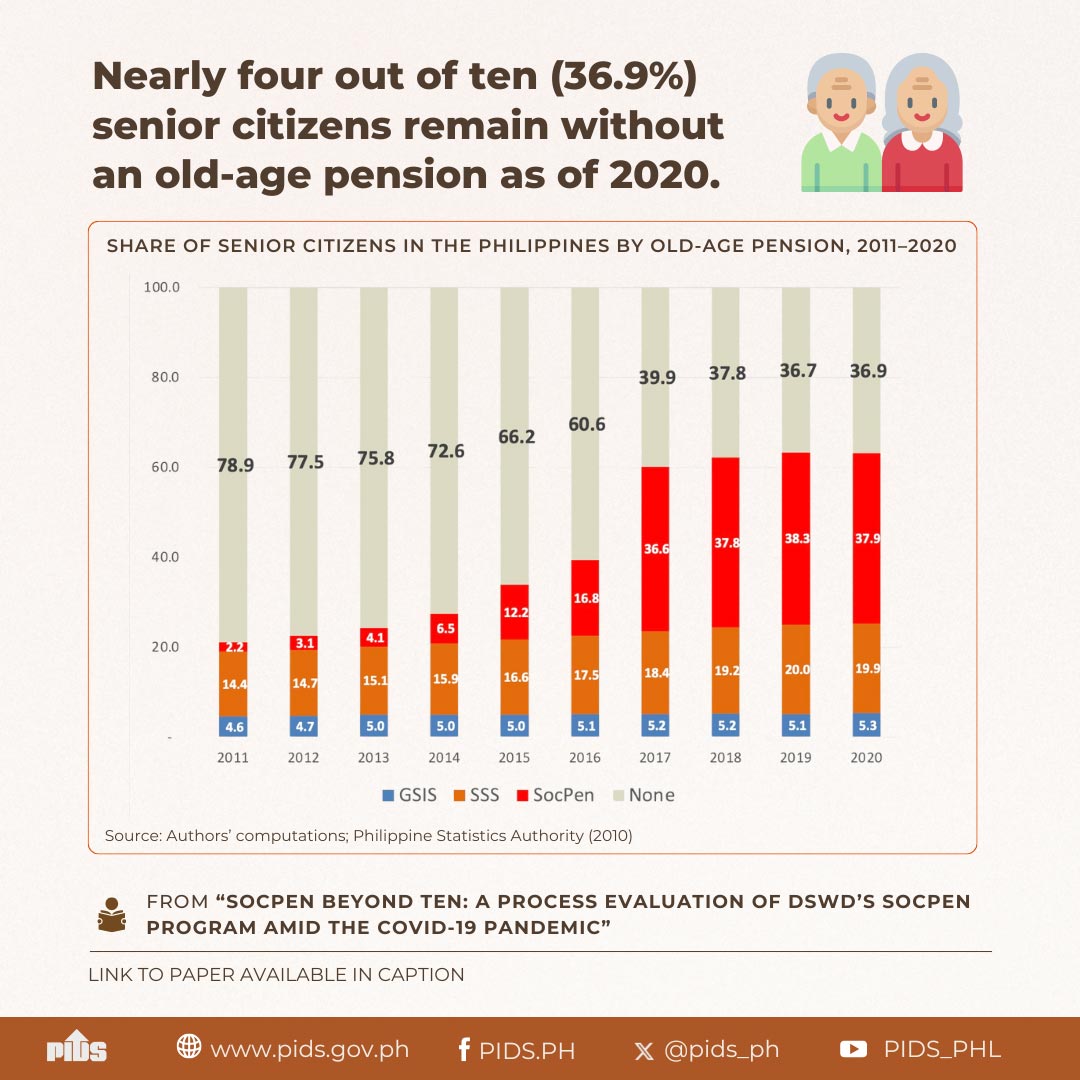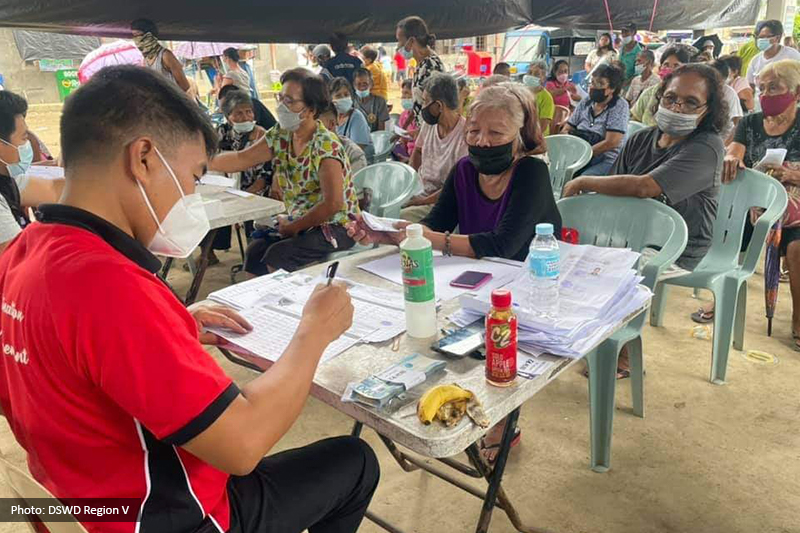
The Social Pension for Indigent Senior Citizen program, also known as SocPen, has contributed to improving the coverage of the country’s pension system. Despite this, implementation issues still hinder the program from achieving its full potential.
This was revealed by a recent study of the Philippine Institute for Development Studies (PIDS) authored by PIDS Senior Research Fellow Jose Ramon Albert, PIDS Consultant Jennifer Monje, and PIDS Research Assistant Mika Muñoz.
Implemented by the Department of Social Welfare and Development (DSWD), SocPen provides a noncontributory monthly stipend of PHP 500 to qualified indigent senior citizens to augment their daily allowance on food and medicines.
The study found that SocPen is “viewed very positively by program implementers and senior citizens alike, in the sense of [the] government providing social assistance targeted for indigent elderly without pensions”.
However, the authors said issues involving the program design, service delivery, and implementation, as well as the organizational aspects of the program, need to be addressed to make it more impactful.
For one, the study emphasized the need to increase the value of the program’s cash assistance and reexamine the targeting of its beneficiaries.
“The current cash benefits for SocPen beneficiaries have not been adjusted for inflation since program inception. Even as early as 2012, [an] internal DSWD [study] already called for at least a doubling of the cash assistance, largely because the amounts are inadequate,” the authors explained.
To do this, the study said a clearer definition of “indigents” that is tied to the poverty or low-income status of a senior citizen is crucial. Further, the DSWD and Congress may need to “seriously consider having three levels of cash support—PHP 1,000 for the lowest income decile, PHP 750 for the second decile, and PHP 500 [the current amount] for the third to the fifth deciles”.
On the targeting of beneficiaries, it recommended updating and merging the SocPen beneficiary database with other interoperable databases of the DSWD, such as the Listahanan, the Social Welfare and Development Indicators, and the [Social Amelioration Program] SAP database.
“One clear rationale for doing this is to find out what income category the SocPen beneficiaries belong to, especially as the Listahanan can yield an income variable using the proxy means income model,” the authors explained.
Another problem is the lack of dedicated staff for SocPen. As DSWD’s second-largest social protection program, the authors underscored the importance of deploying dedicated staff to address data analytic issues and logistical challenges during payout periods.
Meanwhile, the study also urged the standardization of the program’s application process. Some beneficiaries have reported experiencing problems, such as not getting interviewed despite submitting documents, not knowing what to do after submitting forms and going through an interview, and not knowing whether to wait for updates on their applications.
Finally, in terms of cash distribution, the authors suggested adopting a digitized mode of cash payment for SocPen beneficiaries, including the use of e-payments and e-wallets.
This is especially applicable to beneficiaries who have access to technology or are near city centers where cash assistance can be easily accessed. In doing so, the authors pointed out that SocPen staff in charge of payouts can attend to beneficiaries in far-flung areas or those with no access to technology. ###
This study is based on the PIDS discussion paper titled “SocPen Beyond Ten: A Process Evaluation of the DSWD Social Pension (SocPen) Program for Indigent Senior Citizens amid the COVID-19 Pandemic”.
Learn more about this study by watching the PIDS webinar “Making the Social Pension (SocPen) Program More Beneficial to Indigent Seniors amid the COVID-19 Pandemic” on February 17, 2:00 to 4:30 pm. To join, register at https://bit.ly/pidswebinarSocPen by February 15. Alternatively, watch the livestream on the PIDS Facebook at https://www.facebook.com/PIDS.PH, with live tweets of the webinar highlights at https://twitter.com/pids_ph.
This was revealed by a recent study of the Philippine Institute for Development Studies (PIDS) authored by PIDS Senior Research Fellow Jose Ramon Albert, PIDS Consultant Jennifer Monje, and PIDS Research Assistant Mika Muñoz.
Implemented by the Department of Social Welfare and Development (DSWD), SocPen provides a noncontributory monthly stipend of PHP 500 to qualified indigent senior citizens to augment their daily allowance on food and medicines.
The study found that SocPen is “viewed very positively by program implementers and senior citizens alike, in the sense of [the] government providing social assistance targeted for indigent elderly without pensions”.
However, the authors said issues involving the program design, service delivery, and implementation, as well as the organizational aspects of the program, need to be addressed to make it more impactful.
For one, the study emphasized the need to increase the value of the program’s cash assistance and reexamine the targeting of its beneficiaries.
“The current cash benefits for SocPen beneficiaries have not been adjusted for inflation since program inception. Even as early as 2012, [an] internal DSWD [study] already called for at least a doubling of the cash assistance, largely because the amounts are inadequate,” the authors explained.
To do this, the study said a clearer definition of “indigents” that is tied to the poverty or low-income status of a senior citizen is crucial. Further, the DSWD and Congress may need to “seriously consider having three levels of cash support—PHP 1,000 for the lowest income decile, PHP 750 for the second decile, and PHP 500 [the current amount] for the third to the fifth deciles”.
On the targeting of beneficiaries, it recommended updating and merging the SocPen beneficiary database with other interoperable databases of the DSWD, such as the Listahanan, the Social Welfare and Development Indicators, and the [Social Amelioration Program] SAP database.
“One clear rationale for doing this is to find out what income category the SocPen beneficiaries belong to, especially as the Listahanan can yield an income variable using the proxy means income model,” the authors explained.
Another problem is the lack of dedicated staff for SocPen. As DSWD’s second-largest social protection program, the authors underscored the importance of deploying dedicated staff to address data analytic issues and logistical challenges during payout periods.
Meanwhile, the study also urged the standardization of the program’s application process. Some beneficiaries have reported experiencing problems, such as not getting interviewed despite submitting documents, not knowing what to do after submitting forms and going through an interview, and not knowing whether to wait for updates on their applications.
Finally, in terms of cash distribution, the authors suggested adopting a digitized mode of cash payment for SocPen beneficiaries, including the use of e-payments and e-wallets.
This is especially applicable to beneficiaries who have access to technology or are near city centers where cash assistance can be easily accessed. In doing so, the authors pointed out that SocPen staff in charge of payouts can attend to beneficiaries in far-flung areas or those with no access to technology. ###
This study is based on the PIDS discussion paper titled “SocPen Beyond Ten: A Process Evaluation of the DSWD Social Pension (SocPen) Program for Indigent Senior Citizens amid the COVID-19 Pandemic”.
Learn more about this study by watching the PIDS webinar “Making the Social Pension (SocPen) Program More Beneficial to Indigent Seniors amid the COVID-19 Pandemic” on February 17, 2:00 to 4:30 pm. To join, register at https://bit.ly/pidswebinarSocPen by February 15. Alternatively, watch the livestream on the PIDS Facebook at https://www.facebook.com/PIDS.PH, with live tweets of the webinar highlights at https://twitter.com/pids_ph.

